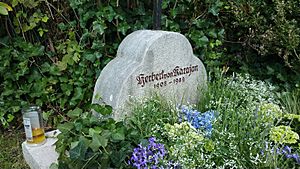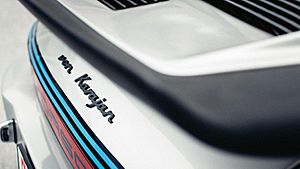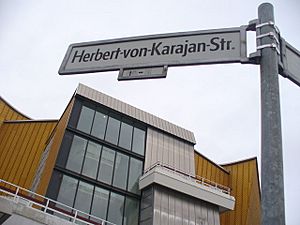Herbert von Karajan facts for kids
Quick facts for kids
Herbert von Karajan
|
|
|---|---|
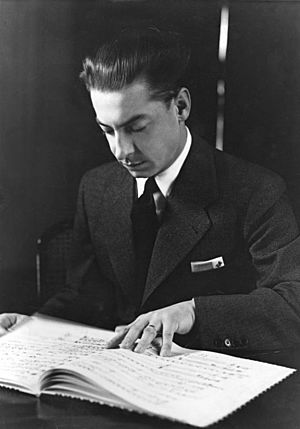
Herbert von Karajan in 1938
|
|
| Born |
Heribert Ritter von Karajan
5 April 1908 |
| Died | 16 July 1989 (aged 81) Anif, Austria
|
| Occupation | Conductor |
| Years active | 1929–1989 |
| Political party | Nazi Party (1933–1945) |
| Spouse(s) |
|
| Children | Isabel and Arabel Karajan |
| Signature | |
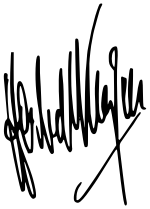 |
|
Herbert von Karajan (born Heribert Ritter von Karajan; April 5, 1908 – July 16, 1989) was a famous Austrian conductor. He was the main conductor of the Berlin Philharmonic orchestra for 34 years.
Many people consider him one of the greatest conductors of the 20th century. He was a very important person in European classical music from the mid-1950s until he passed away. He made a huge number of recordings, which helped him become very well-known. Some say he sold about 200 million classical music records, making him the top-selling classical artist ever.
Contents
Herbert von Karajan's Life
Early Years and Education
Herbert von Karajan was born in Salzburg, Austria-Hungary. His father, Ernst von Karajan, was a surgeon, and his mother was Marta Kosmač.
He was a child prodigy on the piano. From 1916 to 1926, he studied music at the Mozarteum in Salzburg. His teacher, Bernhard Paumgartner, saw his amazing talent for conducting. He encouraged Herbert to focus on that. In 1926, Karajan finished his studies there. He then went to the Vienna Academy to study piano and conducting.
Starting His Career
Karajan first conducted in Salzburg on January 22, 1929. This performance caught the eye of the manager of the Stadttheater in Ulm. This led to Karajan's first job as an assistant conductor there.
Working During the Nazi Era
Karajan's career grew during the time of Nazi Germany. In 1933, he conducted for the first time at the Salzburg Festival. In 1934, he led the Vienna Philharmonic orchestra for the first time. From 1934 to 1941, he conducted operas and concerts at the Theater Aachen.
In 1935, Karajan became Germany's youngest Generalmusikdirektor (General Music Director) in Aachen. He also conducted as a guest in many European cities. In 1938, Karajan made his debut with the Berlin Philharmonic. The same year, he had a big success at the Berlin State Opera with the opera Tristan und Isolde. A critic called his performance "the Karajan miracle." He also signed a contract with Deutsche Grammophon and made his first recordings.
During World War II
Karajan's career continued to do well at the start of World War II. In 1939, the Berlin State Opera made him a State Conductor. He also became the music director of the Staatskapelle Berlin. He toured Rome with them and had great success.
By 1944, Karajan felt he was losing favor with the Nazi leaders. But he still conducted concerts in Berlin in February 1945. Soon after, he and his wife fled Germany to Milan.
After the war, Karajan's past membership in the Nazi Party was looked into. He was cleared of any illegal activity in 1946. Former German Chancellor Helmut Schmidt later said that Karajan was "obviously not a Nazi." He was seen as someone who went along with the system for career reasons.
Post-War Success
In 1946, Karajan gave his first concert in Vienna after the war. He conducted the Vienna Philharmonic. For a short time, Soviet authorities stopped him from conducting because of his past party membership. But this ban was lifted in October 1947.
In 1949, Karajan became the artistic director of the Gesellschaft der Musikfreunde in Vienna. He also conducted at La Scala in Milan. He made many recordings with the new Philharmonia Orchestra in London. He helped them become one of the best orchestras in the world.
Leading the Berlin Philharmonic
In 1955, when Karajan and the Berlin Philharmonic toured the United States, there were protests. Some concerts were even banned because of his past Nazi Party membership.
Despite this, in 1956, Karajan was chosen as the main conductor for life of the Berlin Philharmonic. He took over from the famous conductor Wilhelm Furtwängler.
From 1957 to 1964, Karajan was also the artistic director of the Vienna State Opera. He worked closely with the Vienna Philharmonic and the Salzburg Festival. He started the Easter Festival there.
Final Years
In his later years, Karajan had heart and back problems. He resigned from the Berlin Philharmonic on April 24, 1989. His last concert was with the Vienna Philharmonic. He passed away from a heart attack at his home in Anif on July 16, 1989, at 81 years old.
Karajan was interested in Zen Buddhism. He believed in reincarnation and once said he wanted to be reborn as an eagle. However, he also reconnected with the Catholic Church later in his life. He asked for a Catholic burial.
Family Life
Marriages and Children
On July 26, 1938, Karajan married Elmy Holgerloef, an operetta singer. They divorced in 1942.
On October 22, 1942, he married his second wife, Anna Maria "Anita" Sauest. She was the daughter of a well-known yarn manufacturer. They divorced in 1958.
On October 6, 1958, Karajan married his third wife, Eliette Mouret. She was a French model. Their first daughter, Isabel, was born in 1960. Their second daughter, Arabel, was born in 1964.
After Karajan's death, Eliette continued his musical work. She founded the Herbert von Karajan Centre, which is now the Eliette and Herbert von Karajan Institute in Salzburg. It helps young people develop their musical talents.
Hobbies and Interests
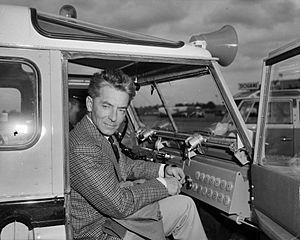
Karajan loved sports. He was a passionate skier and swimmer. He also practiced yoga every day. He enjoyed sailing and won several races with his yachts. He even piloted his own Learjet. He was a big car enthusiast, especially loving Porsche cars. He had a special Porsche 911 Turbo made for him.
Karajan's Musical Style
One of Karajan's special talents was getting beautiful sounds from orchestras. His biographer, Roger Vaughan, noticed how perfect the sounds were. Even the softest parts were clear, and the loud parts peaked exactly right.
How He Conducted
Karajan often conducted with his eyes closed. This is unusual for a conductor, as eye contact is important for talking to the orchestra. But it worked for him. James Galway, a flutist in the Berlin Philharmonic, said Karajan "achieved most of what he wanted through charm."
Closing his eyes helped Karajan focus because he memorized all his music scores. His friend Walter Legge said Karajan never wrote notes on his scores. He would just relax and absorb the music.
Karajan also had an amazing sense of tempo (the speed of the music). He said this skill was learned, not natural. He believed it was the foundation of good music. He would get upset if the orchestra played too fast or too slow.
He once explained why he preferred the Berlin Philharmonic. He said if he told the Berliners to step forward, they would do it. But if he told the Viennese to step forward, they would do it, but then they would ask why. This shows the different personalities of the orchestras.
His Favorite Music
Karajan was known for conducting almost all kinds of classical music. This included music from the Baroque era to the 20th century. He admired Glenn Gould's performances of Bach's music. He also recorded Haydn's symphonies, which are considered some of the best. His many recordings of Beethoven's symphonies are still very popular.
However, Karajan was most interested in music from the late 1800s to the mid-1900s. He especially loved the composers Anton Bruckner and Jean Sibelius. He felt a deep connection to their music, describing a sense of "elemental power." Sibelius himself once said, "Karajan is the only conductor who plays what I meant."
Karajan was also a great opera conductor. He loved the works of Wagner, Verdi, Richard Strauss, and Puccini. He learned a lot about Verdi's opera Falstaff from the famous conductor Arturo Toscanini.
Using Recording Technology
Karajan conducted and recorded a lot of music. Most of his recordings were with the Berlin Philharmonic and the Vienna Philharmonic. He made over 330 recordings with Deutsche Grammophon.
In 1981, Karajan's recording of An Alpine Symphony was the first work ever put on a compact disc (CD). He spent the 1980s making many digital recordings. He even re-recorded Beethoven's symphonies in digital format.
Karajan also filmed his performances for a company called Unitel and his own company, Telemondial.
Karajan's Impact
Karajan's concerts were big cultural events. Famous musicians like Zubin Mehta and even Frank Sinatra attended his concerts. Karajan was more interested in promoting music itself than in his own fame. He said, "When I am on the podium, I forget all about the public. I am not interested in publicity. I can only hope there is an advantage to my being known in the world, that through the interest people take in me, they will then move on to an interest in music."
Karajan's legacy is also linked to his use of recording technology. He made over 800 recordings, which is far more than other conductors of his time. Deutsche Grammophon said his albums sold "probably hundreds of millions" of copies. He earned a lot of money from record sales and conducting fees. He remains one of the top-selling classical music artists even decades after his death.
Awards and Honors
Karajan received many awards and honors. He became a Grand Officer of the Order of Merit of the Italian Republic in 1960. In 1961, he received the Austrian Medal for Science and Art. He also got the Grand Merit Cross from Germany.
In 1977, Karajan won the Ernst von Siemens Music Prize. He also received honorary degrees and gold medals from various societies. He won two Gramophone Awards for his recordings. In 1984, he received the Eduard Rhein Ring of Honor. He was voted into the first Gramophone Hall of Fame in 2012.
From 2003 to 2015, the Festspielhaus Baden-Baden gave out the annual Herbert von Karajan Music Prize. In 2003, Anne-Sophie Mutter, who had debuted with Karajan in 1977, was the first to receive it. Since 2015, the Herbert von Karajan Prize is given at the Salzburg Easter Festival.
Karajan was made an honorary citizen of Salzburg (1968), Berlin (1973), and Vienna (1978). Since 2005, his legacy is managed by the Eliette and Herbert von Karajan Institute.
Grammy Awards
Karajan won three Grammy Awards. He won Best Opera Recording for Bizet's Carmen in 1964 and Wagner's Siegfried in 1969. He also won Best Classical Orchestral Performance for a Beethoven symphony cycle in 1978. His Beethoven recordings are still very popular and highly praised.
Monuments
Karajan is still remembered in the cities where he lived. Statues and monuments have been put up in his honor. In Salzburg, there is a life-sized statue of him outside his birthplace. In Berlin, a bronze bust of Karajan was put in the foyer of the State Theatre in 1983.
Famous Recordings
Karajan signed a contract with Deutsche Grammophon in 1938. He was known for his careful perfectionism in his symphony recordings. He also made many opera recordings, especially those with Maria Callas. Other famous recordings with the Berlin Philharmonic include Also sprach Zarathustra and Mahler's Symphony No. 5.
During his lifetime, people strongly connected Karajan with the works of Beethoven. Karajan recorded four complete Beethoven symphony cycles. He first did one with the Philharmonia Orchestra (1951-1955). Then, he recorded three more times with the Berlin Philharmonic for Deutsche Grammophon (1961–62, 1975–76, and 1982–84).
Karajan preferred to conduct and record music from the first half of the 20th century. This included composers like Mahler, Sibelius, Richard Strauss, and Prokofiev. He performed Shostakovich's Tenth Symphony many times and recorded it twice. Karajan even said that if he had been a composer, his music would have been similar to Shostakovich's.
Images for kids
See also
 In Spanish: Herbert von Karajan para niños
In Spanish: Herbert von Karajan para niños
- Gottbegnadeten list
- Debussy: Pelléas et Mélisande (Herbert von Karajan recording)
- Mozart: Le nozze di Figaro (Herbert von Karajan recording)


